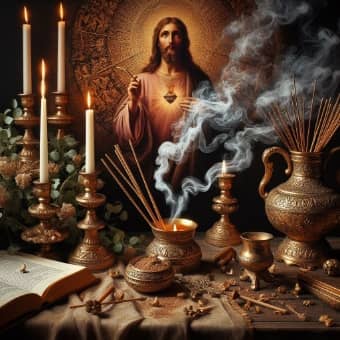The use of candles and incense holds significant symbolism and spiritual importance in the Bible and in the Church
Introduction
From the Old Testament to the New Testament, the presence of candles and the aroma of incense have been integral elements of worship, prayers, and sacred ceremonies.
In this article, we will explore the biblical references and deeper meanings associated with candles and incense.
This blog post contains affiliate links. When you click on a link on this page and make a purchase I may earn a small commission, at no additional cost to you. Thank you for your support.

Candles in the Bible
Candles are often mentioned in the Bible to symbolize light, illumination, and divine presence. Jesus himself referred to himself as the “light of the world” (John 8:12).
In the context of this verse, Jesus connects the act of following him with walking in the light. Just as light reveals the path before us, he becomes the beacon that leads us out of spiritual darkness. Through his teachings, actions, and ultimately his sacrifice, Jesus illuminates the way to eternal life and a deeper connection with God.
Moreover, identifying himself as the “light of the world” reinforces the idea that Jesus brings enlightenment and hope to a broken and fallen humanity. In him, we see the perfect embodiment of divine love, mercy, and grace. As we embrace his teachings and strive to follow his example, we invite this light into our lives, allowing it to transform us from within.
Jesus’ self-proclaimed title as the “light of the world” serves as a reminder of the guidance and illumination he offers to all who embrace him. It is an invitation to walk in his light, surrendering to his teachings and experiencing the transformative power of his love.
One of the most well-known references to candles in the Bible is found in Psalm 119:105: “Your word is a lamp to my feet and a light to my path.” This verse beautifully portrays the idea that God’s Word, just like a radiant candle, leads and illuminates the way for believers.
Candles were also used in the Tabernacle and later in the temple rituals as a symbol of God’s presence among his people. The seven-branched candlestick, known as the Menorah, was an essential element of the Tabernacle and later the temple. Its flames represented the eternal light of God, symbolizing His constant presence and guidance.
Bring the Light Home: Symbolic Candles for Your Space
As we’ve explored, light and its representations through lamps and candles hold deep meaning in the Bible. To help you bring that symbolism into your own home and create a space for reflection and faith, we’ve created a collection of candles inspired by these powerful themes:
The Good Shepherd Candle: Reflecting Jesus as the guiding light and protector of his flock, this candle offers a comforting presence. The same image is printed on all four sides of this candle.


Lighthouse with the Virgin Mary Candle: Symbolizing guidance through life’s storms and the unwavering presence of faith, this candle illuminates hope.


Let Your Light Shine Candle: Representing the divine light and the power of God’s grace radiating into the world, this candle serves as a reminder of spiritual illumination.


Discover more ways to bring the light of faith into your life. Browse the complete Faithful Light collection at my Jim’s Faithful Finds store on Zazzle.
Incense in the Bible
The burning of incense holds deep spiritual significance throughout the Bible. The aromatic smoke rising from burning incense was seen as a reverential offering to God, symbolizing prayers ascending to the heavens.
It was a way for individuals to connect with God, seek His favor, and create an atmosphere of worship.
In the Old Testament, the use of incense was strictly regulated and reserved for sacred rituals performed by priests.
In Exodus 30:34-38, God provided Moses with detailed instructions for creating the sacred incense to be used exclusively inside the Tabernacle. The specific ingredients of this sacred incense were stacte, onycha, galbanum, and frankincense, each in equal parts, carefully blended together.
The incense was to be meticulously prepared, ensuring that it was pure and holy. God emphasized that this particular formula was to be used exclusively for the worship of Him and should not be duplicated or used for personal purposes. It was a symbol of the divine presence and an offering of utmost reverence.
The fragrance of this sacred incense was intended to be a pleasing aroma to God, creating an atmosphere of holiness during worship. Whenever the incense was burned, it would rise as a visible sign of prayers ascending to God’s presence and symbolize the spiritual connection between the people and the divine.
By providing these instructions, God made it clear to Moses and the Israelites that worship was to be a solemn and sacred act. The precise formula for the sacred incense emphasized the need for attention to detail and the importance of following divine instructions. It served as a reminder of the people’s covenant with God and their commitment to worship Him with sincerity and reverence.
Through the creation and use of this sacred incense, God established a special way for the Israelites to approach Him in worship and experience His divine presence in the Tabernacle. The formula for the incense highlighted the significance of worship as a sacred moment of connection between God and His people.
In the New Testament, incense is also associated with worship and prayer. In the book of Revelation, incense is described as the “prayers of the saints” before God’s throne (Revelation 5:8). This imagery emphasizes the ongoing connection between believers’ prayers and their presentation to God.
Conclusion
Candles and incense have deep biblical roots and symbolic meanings within the context of worship, prayers, and spiritual devotion. Candles represent God’s guidance and enlightenment, while incense signifies heartfelt prayers and spiritual connection with the divine.
Their symbolism and use throughout the Bible remind believers of the importance of seeking God’s light, wisdom, and guidance in their lives, as well as the value of offering heartfelt prayers and worship.
Religious incense burners are not merely vessels for holding incense; they are symbols of devotion, spirituality, and cultural traditions.
Each design, material, and incense-burning ritual holds profound meaning, adding depth to religious practices across the globe.
So, the next time you encounter the aromatic embrace of incense, take a moment to appreciate the sacred significance of the incense burner and the ancient traditions it represents.
Whether through the flickering of a candle flame or the fragrant smoke of burning incense, these elements serve as reminders of the believer’s relationship with God and the need for spiritual illumination and communion.
Looking for unique Catholic gifts? Check out our gift guide!
